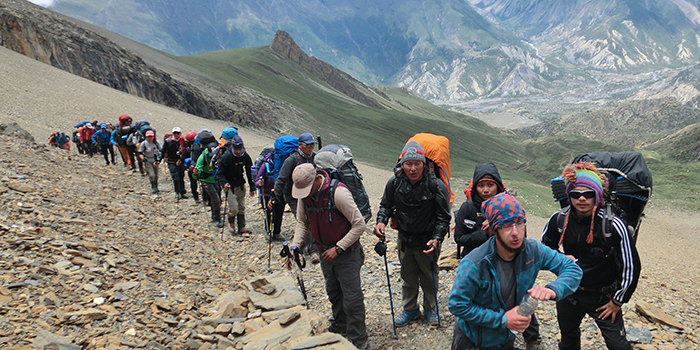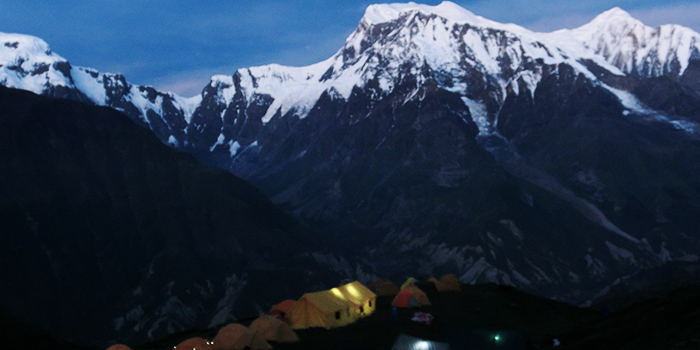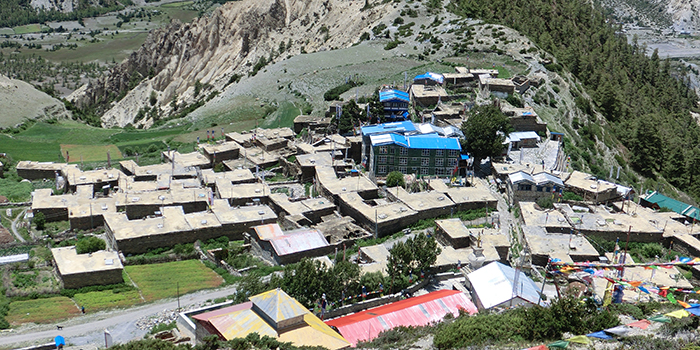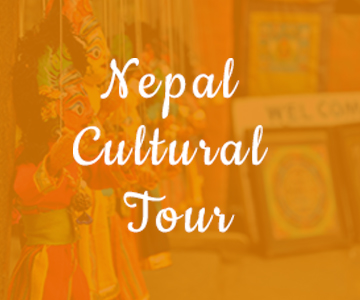Trip Introduction
Nar Phu valley trek opened to trekkers since 2003 lies in the distant land of Upper Manang. The trek covers remote villages, gorge, dense forests, an awe-inspiring landscape, Yak, Gompas and unseen Himalayan tradition. Rarely visited by trekkers in this exotic land serves the unspoiled Tibetan culture and mind-blowing alpine beauty. Nar & Phu valley it is required restricted special permit and government certify guide.
Nar Phu valley has the settlement of about 300 people who depend on livestock, unlike others. And the people are seemed to be least affected by the sealed borders of Nepal with Tibet. This region is a true hidden gem that offers trekkers a rare opportunity to explore unspoiled valleys that feature a mix of raw Himalayan nature and ancient Buddhist culture. This trek starts from Besi Sahar following the famous Annapurna circuit trail leaving this trial at Koto.
This recently opened trial has been able to give some hope to the local people. Local People’s source of income has been depended upon the livestock. Since Annapurna conservation area project (ACAP) seems to be keenly interested in extending its territory to Nar Phu valley, it is doing an immense amount of homework for developing suitable tourism plan.
What's included
-
Three nights accommodation in a three star hotel in Kathmandu including breakfast. This will be for the two nights before trek and one night after trek. Two nights in a three star hotel in Pokhara.
-
All accommodation whilst on trek.
-
Private Vehicle Kathmandu to Dharapani 9 to 10 hours.
-
Jomsom – Pokhara and Pokhara – Kathmandu Round Flight.
-
All domesticc airport taxes.
-
You are able to choose any food, any tea and coffee from menu for breakfast, lunch and dinner.
-
Return transport to the beginning and end of the trek to Kathmandu.
-
Trekking Permits and Nar Phu restricted area permit.
-
An Annapurna conservation permit is also required for this area.
-
Trekking leader, guides accommodation, food and wages.
-
Porter accommodation, food and wages while on trek.
-
Trekking Leader, guides and porters insurance.
-
An English speaking tour guide for Kathmandu sightseeing.
-
Sightseeing fee and guide fee.
-
Private transportation in Kathmandu including all airport arrivals and departures. This is also for the sightseeing tours.
-
All government taxes and service charge.
-
Medical Supplies (frist aid Kit)
What's excluded
-
Nepal visa.
-
International airfare.
-
Travel and rescue Insurance
-
Food in Kathmandu.
-
Extra night hotel accommodation in Kathmandu if arrive early or late departure.
-
All the hotel accommodation or meals in Kathmandu.( in the case return early from trek due to any reason)
-
Personal expenses( bar bills, coke, beer, bottle of water, phone call, laundry service etc.
-
Day 1
Arrival in Kathmandu
Arrive into Kathmandu. You will be met by a member of Top of the World Treks and after a 45 minute bus journey to the heart of the city and check into the hotel there is time for a cup of tea, shower and then a chance to see the tourist district of Kathmandu by night as we go for dinner before an early night!
-
Day 2
Sightseeing in Kathmandu
A day in Kathmandu where we will take you to Swayambhunath which is a Buddhist stupa and Monastery, which is over 2000 years old and one of the oldest in the world. Here is a great chance to see across the valleys, see some monkeys and begin to learn about this fascinating country.The afternoon will be spent getting for the trek and some time to relax and make sure all the kit and packing is complete. Also the first time you can go shopping which in Thamel is an adventure in itself!
-
Day 3
Day 03: Kathmandu to Dharapani (1920m) 8 to 9 hours via to Besisahar.
Today will leave the hustle and bustle of Kathmandu! So our trekking team will come to the hotel in the morning at 4:00am to pick you with private transport. Then you will drive to Besishahar (185km) which will take you about 5 to 6 hours to get in Besisahar. Then again drive Besisahar to Dharapani (1920) by praivate jeep for 3 to 4 hours through the Nagdi, Bhulbhule, Sange, Chamche, Tall and arrive at Dharapani, from on the way you would be able to see wonderful Manaslu Himal range,
-
Day 4
Day 04: Dharapani to Koto (2600m) trekking time 4 to 5 hours.
We leave Dharapani and we climb through the forest to Bagarchhap, this is the first village on the trek with typical Tibetan architecture. The trail is now heading west and we can see the Manaslu ranges and sometimes Annapurna 2. We continue through the forests and we will arrive at Koto (2600m) and our views of the mountains will become perfect. This is nearby Chame headquarters of the Manang district and we are rewarded with very fine views of Annapurna II, Manaslu and Lamjung Himal from Chame as well as two small hot springs. Stay overnight at tea house.
-
Day 5
Day 05: Koto to Meta (3560m) trekking time 6 to 7 hours.
Today we take a different trail onto the Annapurna Circuit. Today we have a long and somewhat difficult day before us. We past the check post and cross a bridge leading to the Nar Phu valley, and hike up through beautiful woods above the Phu Khola (river). The trail leads us through some beautiful forests and passes several small shelters (caves) and a pilgrims’ shelter ('Dharmasala'). As we approach a narrow canyon, the trail actually passes under a wide waterfall just before the Dharmasala from where the woods start to become thinner. We stay overnight at Meta in tea house.
-
Day 6
Day 06: Meta to Phu (4050m) trekking time 6 to 7 hours.
Today is one of the loveliest day of the whole trek as you pass through the landscape combined with white rocks, low shrubs, Juniper, scattered evergreens and sandy trails. During the whole trekking process we can see mountain vista. Then we will trek up to Kayang via Kharka of Meta, Junam and Chako. We will trek to Phu village and Phu valley is known for is unique colorful chorten. The whole trail is scenic. As you enter the Phu village you will see an old gate called Pupigyal Kwe which provides first view of three villages of Phu as well as an old Dzong and remainants of two forts which are situated atop the flatlands before Phu from this region will see the mountains view of Khangaru, Manaslu,Lamjung, Nadi and many more.
-
Day 7
Day 07: Explore & Acclimatization rest day at Phu village.
We walk around to explore the Phu Village. Here remains a unique culture - people’s day-to-days livelihoods are still conducted in the traditional manner. Meet some of the locals and explore up the wide valley systems above us. A day is well spent sitting with the villagers as they spin their yak and sheep wool and chat, pound mustard seeds into a paste for oil, or involve themselves in the numerous activities that constitute a day in the life in a Tibetan village. For photographers, the light here is spectacular and the skies are a deep blue. We may even see some blue sheep on the nearby hillsides. The century old monastery and fort are remarkable. While we wander the village we will probably receive an invitation into someone's home for some authentic Tibetan salt butter tea, or perhaps a small glass of local wine.
-
Day 8
Day 08: Phu to Nar Phedi (3750m) trekking time 6 to 7 hours.
After breakfast, we head back through the Phu gate and then descend again to the river. From there we retrace steps back to Junam Karka, a lovely campsite. The evening was filled with Tibetan and Manangi songs in the smoky shelters accompanied by that unique Tibetan laughter. We are staying at overnight at Nar Phedi.
-
Day 9
Day 09: Nar Phedi to Nar (4150m) Trekking time 3 to 4 hours
Below us sit Gyalbu Kumbu, built in 1650, and Satte gompa, both now empty. Now there are four old and colorful traditional monasteries and the snow-peaks are looming overhead. Finally we reach the Nar gate at the top of the hill. The sights of wonderfully painted, bamboo-topped Chortens await us there. The camp will set up after 3/4hours walking.
-
Day 10
Day 10: Explore & Acclimatization day at Nar village.
Explore the Nar village. Enjoy breathe taking sceneries and fascinating local culture and it has a population of 362 people, living in 86 individual households.In Nar every family have at least one son or daughter in gompa. Stay overnight at camp.
-
Day 11
Day 11: Nar to Ngawal (3675m) via Kang La pass (5315m) 8 to 9 hours.
Today is an adventurous day as we make our way towards the Kang La Pass (5,315m). This is not so difficult in itself but it can make for a long and difficult day if there is snow on the pass or the altitude is taking its toll. The Kang La Pass offers absolutely spectacular view of Annapurna II, Annapurna III, Annapurna IV, Gangapurna, Manaslu, Nadi chuli, Khanggaru, Himalchuli and Tilicho peak. The peaks surrounding Tilicho, the Marsyngdi valley, and the Hunde airport. The trail heads down lightly and we get many enjoyable views of Ngawal with an unusual grouping of Chortens and prayer flags. We can see marks for meditation caves far up in the hills, on the upper Pisang route of the Annapurna circuit which can be reached in as little as two hours from the pass. We now have finished the camping section of the trek here, and head for a guest house for the night!
-
Day 12
Nawal to Manang Trekking time 4 to 5 hours
Trek for three hours through the bank of Marshyangdi River crossing pine forests, Braga village and terraced slopes to Manang.
-
Day 13
Acclimatisation Day
Today acclimatize at Manang. Don’t stay ideal short trek to higher altitude is suggested to get acclimatized to altitude. Bhojo Gompa or Gangapurna Lake is worth visiting sites for getting acclimatized. The next two day trek will be challenging as well as tiring due to rapid gain of altitude.
-
Day 14
Manang to Yak Kharka Trekking time 4 to 5 hours
Trek to Yak Kharka(4,110m) via village of Tenki, Jarsang Khola and Ghunsa village. The trail pass pastures, scrub of Juniper trees. Little but gradual ascent is the key way of avoiding altitude problems.
-
Day 15
Yak Kharka to Thorong phedi Trekking time 4 to 5 hours
Today we will trek to Thorang Phedi(4,600m). Thorang Phedi is a small settlement cartering the needs of trekkers and climbers. We use this point as base camp. Some people try to put base camp at high camp so that the next day can be easier but we do not recommend this as sleeping is higher altitude can be dangerous.
-
Day 16
Thorong phedi to Muktinath Trekking time 9 to 10 hours
Today we trek up to Muktinath(3,800m). To complete the day’s mission we have to start trekking very early. Today we will reach the climax of Annapurna circuit trek. Today you will be experiencing a thrilling adrenaline rush while crossing a famous high pass Thorang La pass.
-
Day 17
Muktinath to Jomsom Trekking time 5 to 6 hours
Muktinath being holy place for both hidus and Buddhist early in the morning we will visit temple and gompa placed here. After visiting to temple we trek down to Kagbeni via Ranipauwa village and then to Jomsom. Spend overnight at Jomsom.
-
Day 18
Fly to Pokhara
Fly from Jonsom to Pokhara. The rest of the day can be spent in Pokhara resting and enjoying the city.
-
Day 19
Sightseeing in Pokhara
A day to explore the city, we will cross the lake and then climb to the World Peace Stupa where you can enjoy the views. If anyone wants to go Paragliding this can be arranged at your own cost.
-
Day 20
Pokhara to kathmandu
We catch a flight back to Kathmandu and then we will go to the hotel. After this you are free for shopping and dinner.
-
Day 21
Departure Day
FLIGHT
For the Nar Phu Valley Regin Treks, you will be flying From Pokhara to Jomsom and Jomsom and then at the end of the trek, you will need to do the return flight. This flight is very weather dependent and can be delayed or cancelled at short notice if the weather is not suitable for this mountain flight. At Top of the World Treks, we will do our best to manage this situation and if your flight is cancelled we will do all we can to get you on the next available flight. It maybe is possible for a helicopter to be charted but this will be at an extra cost and up to the group at the time. We plan extra days into our itineraries in case this happens but you are also welcome to plan extra days if you wish.
IMPORTANT NOTE
Please be aware that your safety while in Nepal is our number one propriety. All itineraries are subject to change if there are safety concerns, health concerns of people in the group and/or weather concerns. This will be decided by the trek leader but we will always discuss the options with the group where possible to ensure peoples wishes are taken into account, however, the Treks leader decision is final.
Book our fixed departures
Equipments
Equipment Check – List
What clothing and equipment to take is one of the things that people worry the most about! We can advise you and help you and it does, of course, depend on the time of year, the area, the altitude and how many days you are trekking/climbing. When you arrive in Kathmandu we will go through all your equipment to ensure that it is correct for your trip. In Thamel (the tourist area of Kathmandu where you will be staying) there is an abundance of shops selling equipment and clothing so if anything is forgotten it can easily be sourced. It is also possible to hire climbing equipment and also items such as down jackets, and sleeping bags saving you a large purchase.
The following equipment list is suggested and necessary for both camping and tea house treks. Use this list as a guideline. The basic checklist should help you with your packing for any of our trips. Please remember that you should always try to keep the weight of your clothing equipment down to a minimum. Your packed trek bag should weigh no more than 15kg. Please remember this is just a checklist and you do not necessarily need to bring everything that is listed below.
GENERAL CHECKLIST
The following basic checklist should help you with your packing for any of our trips. Please remember that you should always try to keep the weight of your clothing equipment down to a minimum. Your packed trek bag should weigh no more than 15 kilograms. Please remember this is just a checklist and you do not necessarily need to bring everything that is listed below. Use your own experience and judgment to make your decision.
-Light and expedition weight thermal tops.
-Fleece jacket or pullover.
-fleece wind –stopper Jacket (optional)
-Waterproof shell jacket (preferably breathable fabric)
-Lightweight thermal gloves.
-Underwear (4)
-Shorts (2)
-Lightweight cotton long trousers/pants.
-Light and expedition weight thermal bottoms.
-Sun hat or Scarf.
-Warm fleece hat or light balaclava.
-T-shirt (2)
-Thin, lightweight (inner socks) (4).
-Sunglasses with UV protection.
-Sleeping bag rated to 0 degrees ¾ season
-Headlamp (eg Petzl) Spare bulbs and batteries.
-Small padlock to lock trek bag.
-Basic first aid kit(see First aid medicine bellow)
-Plastic bags –for keeping items dry inside trek bag.
-Daypack ( 35 to 40 litters/ 2500 to 3000 cubic inches.)
-Camping mattress, eg Thermarest pad.
-water bottles.
-Toiletries.
-Small wash towel.
-Footwear, appropriate to the trip.
-Waterproof shell trousers/pants. (Preferably breathable fabric)
TREKKING CHECKLIST
In addition to the items listed in our general checklist you will need to take the following on your trekking trip:
-Heavyweight gloves or mittens with a waterproof shell outer.
-Down vest and/ or jacket (optional).
-Fleece or wool trousers/ pants.
-Trekking/ hiking boots with spare laces.
-Thick, warm wool hiking socks (4)
– Footwear for around camp, eg running shoes and /or sandals.
-Gaiters (optional).
-Telescopic trekking/ ski poles (optional)
MOUNTAINEERING / CLIMBING CHECKLIST
In addition to the checklists for general trekking equipment above, and depending on the trip you have chosen, various items of mountaineering equipment may also be required, eg:
-Plastic boots and crampons (preferably step – in bindings ) with front points.
-Mountaineering Safety harness.
-Mountaineering Ice axe(60 to 75 cms long – depending on your height and personal preference).
-120 cms (4ft) climbing sling and to locking and unlocking caravans.
-Telescopic ski – sticks (optional).
-Prussik loops.
-Climbing helmet (optional).
-Jumper (Ascender & Descender).
-Pocket Knife.
-Headlamp.
-Mattress.
-Rope and Snow bars.
-Ice crew.
-High altimeter.
Most if not all of this equipment will be needed for any trip that crosses steep, snow-covered ground, or which includes sections of glacier travel. Our recommendation that you take no more than fifteen kilos of trekking equipment dose not include your plastic boots, ice axe, Crampons otherness/carabiners. During the trek, climbing hard wear will be carried separately from your trek bag, in group bags until needed.
EQUIPMENT RENTAL
To minimize your expense outlay for trekking and climbing equipment you may never use again, equipment rental and buying is possible in Kathmandu. You find them a lot cheaper than you find in Europe and the USA. Shops in Thamel offer a wide range of equipment available for rent and buy. Here is some cost which gives you an idea of the cost to rent in Kathmandu.
-Sleeping bags.
-Down Jackets.
-All-purpose mountaineering Ice axe (60 – 70 cms)
-Ice hummer.
-Climbing Harness.
-2 looking Carabiners, Climbing Sling.
-12 – point Crampons.
-Plastic Climbing boots.
-Helmet.
FIRST AID MEDICINE
-Bandage for Sprains.
-Plaster/ Band-aids.
-Iodine or Water filter(optional)
-Moleskin/ Second skin – for blisters.
-Antiseptic ointment for cuts.
-Anti-bacterial throat lozenges (with antiseptic)
-Aspirin/ paracetamol- general painkiller.
-Oral rehydration salts.
-Broad-spectrum antibiotic (norfloxacin or ciprofloxacin).
-Anti – diarrhoea medication (antibiotic).
-Diarrhoea stopper (Imodium – optional).
-Antibiotic for Giardia or similar microbe or bacteria.
-Diamox (Altitude sickness – can be bought in Kathmandu.
-Sterile Syringe set (anti-AIDS precaution).
– For more details please see our staying healthy topic.





